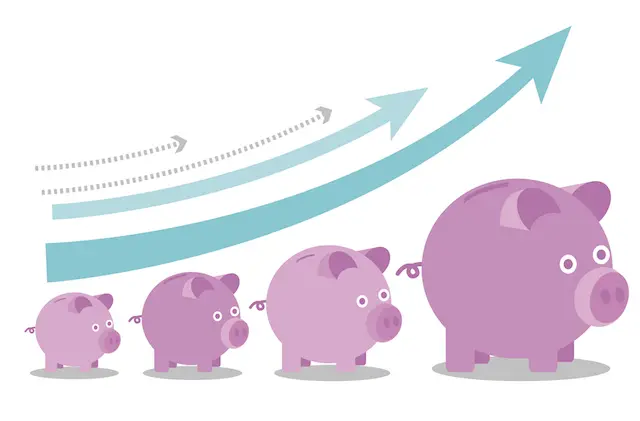The stock market was on a tear last month. The Dow Jones Industrial Average set eight records in November and crossed the 19,000 mark for the first time. The rally began the day after the election of Donald Trump. Yields on 10-year Treasury notes reached their highest level of the year in November. Yields are up as investors are assuming there will be more growth and some inflation under a Trump administration.
TSP Returns in November
The Standard and Poor’s 500 index, the index on which the C fund is based, was up 3.4% for the month.
For funds in the Thrift Savings Plan (TSP), the S fund had the biggest returns providing investors with a 7.95% for November. The S fund is also has the biggest gains for the year with 14.28% so far in 2016. The C fund came finished in second place with a return of 3.71% for November and it is up 9.84% so far in 2016.
The funds losing money in November were the F fund and the I fund. The F fund was down 2.35% for the month but still has a return of 2.75% for the year. The I fund was down 1.99% in November and it is also down 1.29% for the year.
All TSP funds, except for the I fund, are up so far in 2018.
TSP Fund Returns for the Month, Year-to-Date and the Past 12 Months
Here are the results for all of the TSP funds.
| G Fund | F Fund | C Fund | S Fund | I Fund | |
|---|---|---|---|---|---|
| Month | 0.16% | -2.35% | 3.71% | 7.95% | -1.99% |
| YTD | 1.62% | 2.75% | 9.84% | 14.28% | -1.29% |
| 12 Months | 1.80% | 2.44% | 8.00% | 9.817% | -3.29% |
| L Income | L 2020 | L 2030 | L 2040 | L 2050 | |
|---|---|---|---|---|---|
| Month | 0.49% | 1.05% | 1.57% | 1.87% | 2.19% |
| YTD | 2.93% | 4.29% | 5.40% | 5.97% | 6.48% |
| 12 Months | 2.64% | 3.33% | 4.00% | 4.27% | 4.51% |
Bond Yields and the G Fund
As interest rates rise and the yield on bonds goes up, the underlying prices of bonds and bond funds go down. Prices go down because existing bonds will be paying a lower interest rate than new bonds that are issued.
An extreme example was bonds issued by IBM losing 25% in about one year from 1979 to 1980. Inflation hit a high of 20% during the latter stages of the Carter administration. Bond prices fell dramatically and bond holders, including many retirees who were investing in bonds for income and to preserve their money, lost a great deal of money with the dramatic drop in bond prices.
There is no indication that anything as extreme is about to occur. In fact, for those who are fortunate enough to be able to invest in the Thrift Savings Plan, the concern about bond prices as inflation rises is substantially less than for other Americans.
The Unique Nature of the G Fund
Federal employees have an investing advantage over other investors just because they work for the federal government. The G fund is one reason for this distinctive advantage. Much lower expenses for the TSP funds are another reason.
The G fund is not an ordinary bond fund. It is only available to investors in the TSP. The investment objective of this fund is to produce a rate of return that is higher than inflation while avoiding exposure to credit (default) risk and market price fluctuations.
There is the possibility that the G fund will not grow enough to offset the reduction in purchasing power resulting from inflation. That is a small risk compared to the risk taken by most bond investors as their bond funds can sink dramatically if inflation increases significantly. In other words, their purchasing power goes down because of inflation and the underlying value of bond funds will go down even more.
The unique advantage of the G fund is the unique nature of the bonds. The interest rate paid by this fund is based on a weighted average yield of all outstanding Treasury notes and bonds with 4 or more years to maturity. So, participants who invest in the G Fund are rewarded with a long-term rate on what is essentially a short-term security. Generally, long-term interest rates are higher than short-term rates.
The G Fund is invested in short-term U.S. Treasury securities that are issued to the TSP.
Looking to the Future
The Dow Jones Transportation Index had its best month since September 2010 with a gain of 11%. This is significant as many companies in this index transport equipment and material for manufacturing and construction. In other words, there is likely to be a surge in economic activity in these areas as the materials and equipment are delivered to start work on new projects.
According to the Wall Street Journal, “Stock markets have been surging since Election Day as investors look forward to lower taxes and less regulation under President-elect Donald Trump.”
The Journal writes that a new monthly employment survey by the National Federation of Independent Business indicates that small business owners are preparing for a better future and plan to increase hiring. 17 percent of small companies plan to increase employment while 9 percent are planning reductions according to the same article. This will not impact short-term hiring trends but will have an impact in the future. “The owners of public corporations and the owners of small private firms are now both expecting faster growth under Trumponomics.”
On the other hand, investors should be cautious. Little is known about many policies that will be pursued by the new administration. Many decisions impacting the economy will also be made by the new Congress. There is little certainty about the decisions Congress will make.



